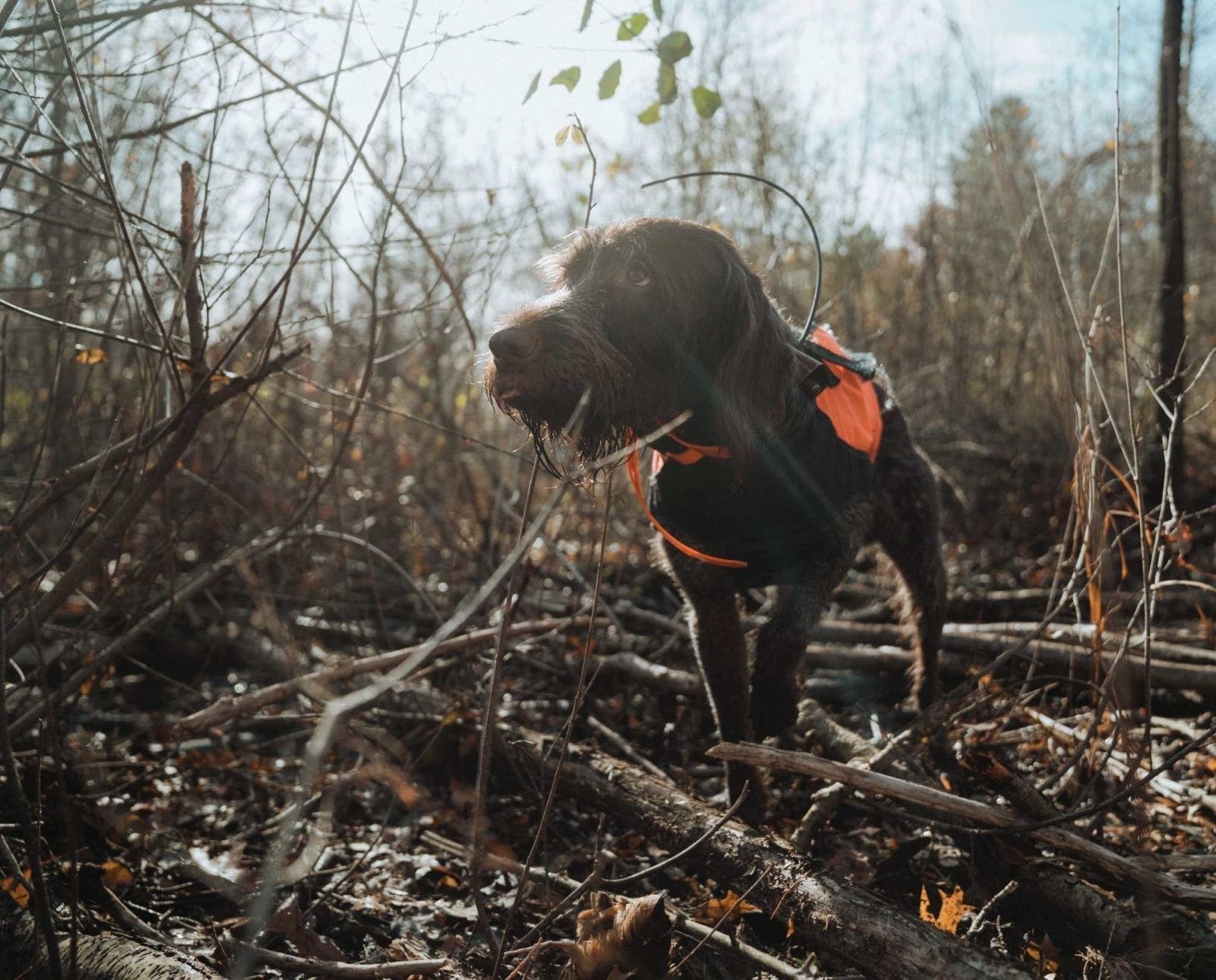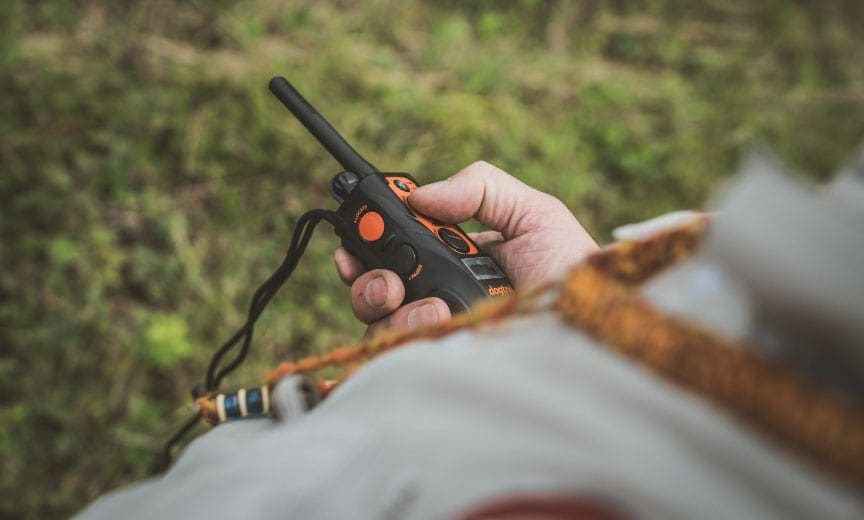Home » Hunting Dogs » Introducing a Dog to an E-Collar – A Guide to Collar Conditioning
Introducing a Dog to an E-Collar – A Guide to Collar Conditioning

Jason Carter is a NAVHDA judge, NADKC member, director of…
Learn about properly introducing a dog to an e-collar and correct applications in training and the field
I grew up during what appears today to be the stone age of upland hunting. It’s hard to believe we could simply throw on a bell and go out hunting. Admittedly, there were plenty of frustrating days when the dogs were having a really good time without us. It was just part of the gig back then. We talked to our dogs a lot, constantly commanding to keep them close and if possible, correcting what we could see and more often what we could hear. We were trained to follow the bell and never let it out of hearing range. When a dog went on point we would break into search parties to locate it. If we couldn’t find it, a shot would be fired into the air in hopes we would hear a ding of the bell.
Listen to more articles on Apple | Google | Spotify | Audible
With the development of today’s hunting technology, we now have the luxury of knowing more about our hunting dogs than ever before. We can hunt comfortably, saying very little to our dogs while enjoying all the sights and sounds our covers have to offer. We know where our dogs are, where they’ve been, how fast they are moving, when they are pointing, or when they are not. We are even able to extend our physical influence out for miles. Though electronic collars (e-collars) are amazing, it’s important to recognize that they are your best friend and your worst enemy at the same time.
E-collars are not teaching devices
Knowing how to properly use one takes patience, thoughtful practice, and a fair amount of guidance. There is an art to using this technology to supplement your dog’s training. When e-collars first hit the market in the late sixties, they were essentially cattle prods with fry only settings giving them a well-deserved reputation of being inhumane. As the technology improved over time, e-collars have become a fantastic supplemental tool in our training repertoire with their many supportive features. The functionality of e-collars today makes them incredibly versatile, with stimulation levels even less averse than leashes, whistles, or verbal commands.
Though counter-intuitive, e-collars should not be used as a teaching device, but rather as an extension of your training by reinforcing prior knowledge. Handlers, like their dogs, often become collar-dependent to the point that they are unable to train or hunt without one. Somewhere down the line they lost that personal connection with their dog where the dog wanted to please its owner. Instead, the dog works to avoid pressure. Once that pressure abates, the corrected behaviors return.
Something to always remember is that a dog that wants to work is far more reliable than a dog that has to. We try to follow the 4:1 reward rule when we train. If I’m not rewarding my dog four times before needing to make a correction, I’ll back up and fix holes in his learning. It’s important to understand that the e-collar can be unforgiving in the wrong hands. Make no mistake: improper use can be a career-ending experience for your hunting buddy. Alternatively, using the tool correctly provides accountability and reliability, and deepens the understanding of your training.
Types of e-collars available
The technology and variety of e-collars in today’s market can be somewhat mind-boggling. Finding the right collar for the job requires a fair amount of research. They vary greatly in size, shape, controls, and features. Do you need a GPS, mapping abilities, a touch screen? Do you prefer a rheostat or leveled dial(s)? Do you want to be able to connect to your watch or phone? There are so many options out there right now that it makes it difficult to choose.
While you should decide what features work for your needs, I can say that you get what you pay for. The features, battery life, durability, and stimulation options are limited in some of the lower end collars. Though every collar has its strengths and limitations, they are all only as good as the person operating them. Learning how to utilize the collar to pull out the best in your dog takes some time. If possible, either connect with your local NAVHDA chapter or contact a professional trainer. Both will have worked with a variety of brands of collars and have a bit more hands-on experience. They can help you find the right collar and learn how to provide an appropriate level correction with perfect timing before even putting the collar on your dog. Trial by fire is a risky endeavor when it comes to collar conditioning.
Though we are getting close, in my experience, the perfect collar for both training and hunting has yet to be made (Disclaimer: There are systems out there I have not worked with). Without delving too deep into product review, I’ll share what I use for collars in terms of usability for training and hunting. For training, I need a collar I can manipulate without taking my eyes off the dog. If I have to look at the remote or if it takes more than half a second to change levels, it won’t be the collar I use for training.
For years, my go-to collar was the Dogtra T&B 2700 series. As discussed in previous articles, timing is everything in dog training. For this reason, I love Dogtra’s ease of the rheostat dial, allowing me to go to a lower stimulation than most other leveled collars and seamlessly adjusting to the character of the dog in the moment. The motion detection technology indicates the point within roughly three seconds which can be about half the time of a GPS collar depending on the covert and day. I also like to throw on a small bell for those sneaky stalkers that learn to creep towards the bird without the collar detecting the dog’s movement. I still have good hearing, so between the bell and my e-collar set on “point only” mode (which means it remains silent until the dog locates a bird) I have all I need to train successfully in the field or woods. Again, this method is for those with good hearing.
For hunting, I like to use an all-inclusive collar like the Garmin Alpha. It clips easily to my vest and provides everything I need, including stimulation. To have all the features I want, I sometimes run the Dogtra 2702 and Garmin Astro (using the “no stimulation” option) together. This provides my preferred stimulation controls, locate tones, and all the GPS functions I need. The only drawback is that we carry twice the gear.
For those losing the beeper and bell range of their hearing or for far-ranging dogs, the Garmin GPS collars make a world of difference. The GPS features have proven to be an invaluable tool for me in the brambles of the Northeast, where I live. As hard as I try, I can’t always see what’s going on. Did they blink a retrieve? Did they follow the track? Are they running off or are they coming back? With the GPS feature, I am far more in tune with my dog’s shenanigans. My go-to GPS collar for hunting is the Garmin Alpha for the stimulation, mapping, communication, and ability to run multiple dogs.
For training with a GPS collar, I typically use the Garmin Pro 550 Plus for the simplicity of the controls on the unit and the ability to keep my eyes on the dog without using a touch screen. It lets me know when the dog is on point and provides me the direction and distance from my dog. I can’t say enough good things about the Garmin products and the peace of mind they provide. One problem I’m currently looking into with my GPS devices, are the delays that I get from when my dog goes on point to when I receive notification on my handheld. The collar runs on an accelerometer that refreshes every 2.5 seconds. When the dog stops moving, the collar—which is receiving signals from multiple satellites—indicates a point. Though in a dense covert on a cloudy day, I may see some delay. They do make a locator beeper; however, at this point, it does not communicate with the Garmin handheld. That being said, all of these products are fantastic to work with and advancing by the minute. I highly recommend that you give them a try.
Collars today have three ways to stimulate your dog: tone, vibration, and electrical stimulus. Dogs respond differently to each, so it will be your job to figure out what best meets the needs of your dog and what stimulation provides the right level of response in them.
Typically, the electrical stimulation comes in two forms: continuous and momentary. The momentary stimulus is only for a fraction of a second whereas continuous can last up to 12 seconds. The duration of the continuous “stim” is controlled by the handler. It is also important to note that at the same setting, continuous mode will elicit a stronger reaction than momentary mode. We sometimes mistake a dog’s confusion for disobedience. If an inexperienced collar user responds by increasing the stimulation level, then instead of guiding the dog away from confusion we lead them towards fear. This results in the dog shutting down and losing trust. You need to know what you’re doing when using the continuous mode in your training. The same can be said when using a collar around water, as a wet dog is more reactive to stimulus than a dry one. Always train toward the sensitivity of your dog and be very careful not to over-correct when using the e-collar.
When should I start using an e-collar?
The question I get asked most is, “When should I start using an e-collar?” Focus on developing drive and the love of the hunt before putting on the controls. It’s not something you want to rush. Typically, dogs begin to dictate their own choices in the field between six and twelve months of age. The drive for game begins to overpower its cooperation and obedience. That’s the point at which I begin to condition my dog.

What stimulation level should I train at?
The answer is: I’m all over the dial. The character of the dog dictates the correction. Too high, my dog quits and learns to fear everything relating to that moment, be it the gun, birds, decoys, those particular training grounds, or me. Too low and they learn to ignore the stimulus.
This is where the art of reading your dog comes into play. The correction should gain its attention without diminishing the dog’s drive. This happens in subtle ways. You may see submissive lip licking and eye blinking, a slight twitch, or a freeze in action and eye movement. Another thing to note is that the sensitivity to the stimulus is in constant flux. I’m continuously moving up and down the dial depending on what I see. In time you get a feel for reading your dog and the levels that work best for it relying on the least to most approach.
The key to e-collar training is to read your dog and anticipate the necessary level of correction though ready to make quick adjustments as needed. Too often folks are fumbling for their remote and missing that imperative half-second correction window for the dog to be able to connect its action to the correction.
One thing I like to do with clients is to ask them, “Did you see that shot!” If they answer yes, I know they weren’t watching their dog. I also like to role play with the collar. I will perform various misbehavior’s as the dog and have them practice manipulating the collar corrections depending on the behaviors I exhibit. I find it helps them coordinate the timing of their corrections. Typically the corrections are missed completely or delayed to around two seconds. Though within a short time they usually figure out the timing and begin to properly read the situation and can anticipate and coordinate how to correct it.
Listen To: Using Remote Training Collars with Pete Fischer of Dogtra
How do I collar condition my dog?
There is an infinite number of ways to collar condition your dog. One of the common practices and one I use as well is to first teach your dog that the collar means to go away before using it to reel it in. I want to be able to push my dog out with a collar if necessary. Too often we use it exclusively for come and the dog learns to escape the pressure by returning to its handler. For pointing dogs this can be problematic as you can imagine. In the early development of the puppy, I have already taught it to go away into its kennel, to go to a place, be it a mat or a board, whoa on command and recall accurately. The stronger the understanding of these commands the smoother the collar conditioning will go. Once your dog has a firm grasp on these concepts, we can take you through a series of drills to help collar condition it. These drills will create an introductory foundation that you can take to the field.
(Equipment: e-collar, kennel, a long lead, treats, and some place boards or mats.)
Collar conditioning is encouraging the dog to avoid pressure. We are teaching them to go, to come, and to stop. It teaches them how to relieve the pressure of the collar. We start by stimulating on command and physically guiding them towards the objective. Once they understand what you’re asking, we will then stimulate after the command as a correction for disobedience.
- Command – “Kennel”
To be sure there is no confusion, I like to attach a long lead onto the dog and pull it through the back of the kennel. On the command kennel, I assist them into the kennel or dog box. Once they get good at it, I will overlay the e-collar with a very light continuous stimulation for about two seconds.
Set the dog up just outside the box. On the word kennel, begin the stimulation and pull the lead until they’re inside the box. Release the pressure the moment the dog initiates movement towards the box on its own. Once there is understanding, I remove the lead and repeat the exercise.
As the dog becomes reliable, I begin to systematically back away from the box until they are driving themselves in on command. The light continuous stimulation is removed and a nick is now used for disobedience only. If they freeze and look confused, you’ll need to back up and give them more guidance. If they become frightened, the pressure is too high and you’ll need to take a break, shorten back up, and start again at a lower stimulus.
- Command – “Place”
Following the same procedure, take two boards, rugs, or blind mats and teach your dog to target them on the command place. To do this by placing two target mats relatively close together. Hook on a lead and pull them to a mat on the command place. When they get on the mat reward them with the marker word yes or another of your choice. Reward them generously and repeat. Continue until they are eagerly driving between mats. Now, like before, overlay the collar and lead on the command place. Systematically grow in the distance so they maintain success and make the reward worth working for.
- Command – “Whoa”
In our system of training, we teach our dogs to whoa on command verbally, visually, and with a whistle. We go through an extensive series of exercises first starting on the training table, to the ground using place boards, on a long lead, and finally overlaying it to an e-collar. It’s very important to us that the dog understands how to stand whoa with collar pressure prior to going to the field.
- Command – “Come”
Lastly, we teach our dogs to recall. Before this collar work, I again have worked extensively developing a bombproof recall where the dogs happily and eagerly drives back to me. I will place the dog on a lead in distraction and will give the command to come with a pop of the lead and a light momentary nick. The moment the dog initiates returning, I drive it back with praise and a reward at the finish. The momentary nick should not diminish the eagerness to recall.
The e-collar is simply an extension of the long lead. It’s a tool that shouldn’t be used as a crutch and doesn’t replace hands-on training. It’s simply a way to help better connect you with your dog when they are out of reach. I can’t stress enough the importance of being a fair trainer, especially when using electronic collars. If you do your research and find the right collar, go ahead and practice coordinating your collar skills before putting it on your dog. You need to know what you’re doing. Getting that timing right with the appropriate stimulation while erring on the side of caution is key. If possible find a trainer in your area to help assist you through the process. Good luck.
SUBSCRIBE to the AUDIO VERSION brought to us by: ESP – Digital Hearing Protection for FREE : Google | Apple | Spotify
Jason Carter is a NAVHDA judge, NADKC member, director of youth development, secretary of NAVHDA’s youth committee, clinic leader and trainer at Merrymeeting Kennels. He has been around versatile hunting dogs his entire life, literally! Born into the Carter family and Merrymeeting Kennels, he attended his first NAVHDA test in Bowdoinham, Maine, when he was just a year of age. Jason successfully trains, tests and breeds Deutsch Kurzhaars in both the NAVHDA and NADKC testing systems. Through his work at the kennel, Jason has had the opportunity to develop pointers, flushers and retrievers over the years. When October arrives he can be found with family and friends hunting throughout New England.




